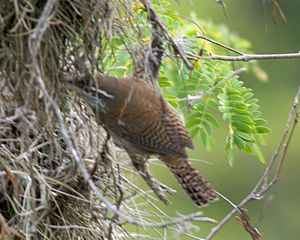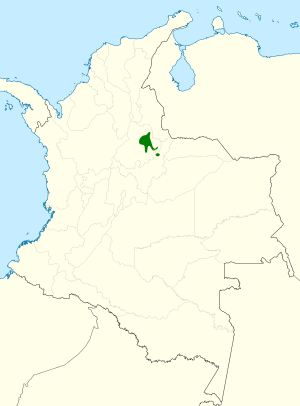Niceforo's wren facts for kids
Quick facts for kids Niceforo's wren |
|
|---|---|
 |
|
| Conservation status | |
| Scientific classification | |
| Genus: |
Thryophilus
|
| Species: |
nicefori
|
 |
|
| Synonyms | |
|
Thryothorus nicefori |
|
The Niceforo's wren (scientific name: Thryophilus nicefori) is a small bird that belongs to the Troglodytidae family, also known as wrens. This special bird can only be found in Colombia, which means it is endemic to that country. It lives in dry, high-up areas with lots of shrubland. Sadly, its home is shrinking, which puts this wren in danger. In Spanish, people call it Cucarachero de Nicéforo or Cucarachero del Chicamocha.
Contents
About Niceforo's Wren
Naming the Wren
The Niceforo's wren was first officially described in 1946. This was done by an American bird expert named Rodolphe Meyer de Schauensee. The name of its group, Thryophilus, comes from old Greek words. Thryon means "reed," and philos means "loving." So, it's like a "reed-loving" bird.
The species name, nicefori, honors Brother Nicéforo María. He was a Colombian missionary and reptile expert. He helped Meyer de Schauensee by providing many bird samples. The first birds were found near San Gil in Santander, Colombia.
What Does It Look Like?
This wren is a medium-sized bird, usually about 14.5 to 15 centimeters (around 6 inches) long. Adult birds have a dull olive-grey color on their head and back. Their wings have thin stripes, and their tail has wider stripes.
A long white stripe, called a supercilium, goes above its eye. This stripe has thin black lines around it. Its face has black and white streaks. The bird's belly is white, turning grey on its sides. The feathers under its tail have wide black stripes. Young birds of this species have not been described yet.
Where Niceforo's Wren Lives
Its Home in Colombia
Niceforo's wren lives only in the valley of the Chicamocha River in Colombia. It is also found in the Sogamoso, Suaréz, and Fonce river areas. These places are in the Boyacá and Santander regions of central northern Colombia.
After the first birds were found in the 1940s, no one saw them again until 1989 and 2000. This might have been because the area was hard to visit for many years. Later, in 2005, new groups of these wrens were found near Soatá. More were found in the Serranía de los Yariguíes area between 2004 and 2006.
Preferred Habitat
This wren lives in dry forests at high altitudes, between 1,132 and 1,840 meters (about 3,700 to 6,000 feet). It likes areas with lots of plants, a thick layer of plants close to the ground, and plenty of fallen leaves.
Scientists found that the wren often lives where certain plants grow. These include Tricanthera gigantea and Acacia farnesiana. Recent studies also found them in forest parts near rivers. These areas have tangled plants like shrubs and thorny bushes. They also live along the shaded edges of coffee and cacao farms.
Wren Behavior and Life Cycle
How They Find Food
Niceforo's wrens spend most of their time on the ground. They are usually found within 2.66 meters (about 8.7 feet) of the ground. They seem to look for food mainly in the fallen leaves on the ground. They have also been seen picking up insects from under dry leaves. Sometimes, they peck at branches and holes in trees.
Reproduction and Family Life
Niceforo's wrens are monogamous, meaning they have one mate for life. Pairs protect their own areas, which can be from 1 to 4 hectares (about 2.5 to 10 acres) large. These areas are usually along streams and rivers. Scientists have figured out that there might be one wren for every two hectares of suitable land.
Nesting Habits
These wrens build a special nest that looks like an elbow. It has an entrance on one side near the top and a round base. They place these nests high up in trees, usually between 3 and 10 meters (about 10 to 33 feet) above the ground. The trees themselves are often 12 to 16 meters (about 39 to 52 feet) tall.
They use plant fibers, parts of fungi, twigs, and vines to build a very dense nest. Interestingly, Niceforo's wrens build their nests near wasp colonies. This is a smart move! The wasps help protect the baby wrens from predators. Other types of wrens and some tropical birds also use this trick.
Protecting the Wren
Current Status
Niceforo's wren is listed as critically endangered. This means it is at a very high risk of disappearing forever. Both the IUCN Red List and the Red Book of the Birds of Colombia list it this way. Surveys done between 2004 and 2008 found only 77 individual birds. Based on this, experts believe there are only about 30 to 200 adult wrens left in the world.
The remaining groups of wrens are very spread out. No single place has more than 50 birds. The biggest danger to this species is the loss of its habitat. All known groups of wrens are losing their homes. Forests are being turned into farms, and goat farming also harms the plants the wrens need. Forest fires and drying rivers also threaten their homes.
Conservation Efforts
In 2003, a project called Project Chicamocha started. Its goal was to help save two special species in the Chicamocha Valley's dry forest. These were Niceforo's wren and the Chestnut-bellied hummingbird. This work led to the creation of the Niceforo's Wren Natural Bird Reserve in Zapatoca in 2009.
This reserve is run by a Colombian NGO called Fundación ProAves. It protects 1,400 hectares (about 3,460 acres) of dry forest. This area is home to a group of 21 wrens found in Santander Department in 2008. Another group of wrens is protected inside the Serranía de los Yariguíes National Nature Park.
The project also helped create the Alliance Chicamocha. This group works to protect the amazing plants and animals of the Chicamocha Canyon. It includes government groups, NGOs, local people, and universities. In the town of Soatá in Boyacá, local groups are also working to protect and study Niceforo's wren. This town strongly supports protecting nature, and they even started the first community reserve in the Chicamocha Canyon.
See also
 In Spanish: Cucarachero de Nicéforo para niños
In Spanish: Cucarachero de Nicéforo para niños


